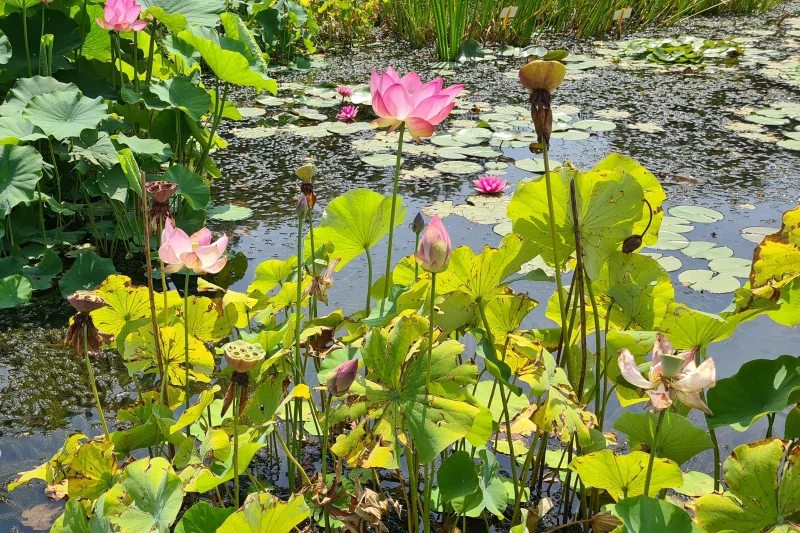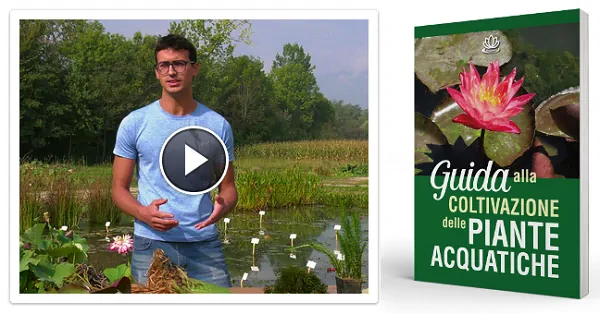
If your lotus flower is weak and yellowing, read this article, because I will give you some useful tips to have healthy lotus flowers.
The lotus is a plant that needs a lot of organic matter to live, in fact it requires a heavily fertilization every year.
Every year you should add 10 to 15 tablets of Osmocote fertilizer, particularly around the perimeter of the tub, where the rhizomes run most. Without fertilizer, the lotus flower becomes weaker and weaker every year, i.e. it tends to make smaller and more yellow leaves and it produces fewer and fewer flowers.
Furthermore, the size of the pot is crucial for good vegetation. A small lotus needs a tub of 45/50 cm in diameter to give you good flowers, while a large lotus needs a tub of at least 80 cm in diameter.
So if your lotus is planted in a smaller tub than these indicated sizes, perhaps the first year it may even manage to vegetate and flower well, but by the second year you will necessarily have to repot and fertilize it.
If you have realised that you have planted it in a tub that is too small, and it is now the second year of that lotus’ life, you can repot it in a larger container and fertilize it, either in early spring (between March and May) or in the middle of the lotus’ vegetation period, around mid-July. The lotus will find itself with new space, new soil and more fertilizer, and it will start vegetating again.
If you repot the lotus in mid-July, you must absolutely avoid damaging/dividing the clod of soil. If the repotting is done in mid-July, the vegetation and flowering can be prolonged throughout September.
If the tub size is appropriate and it is already beyond the month of July, if the lotus starts to turn yellow, you should take into account that the vegetation period of the lotus is shorter than that of water lilies, in fact typically at the end of August the lotus finishes its vegetation period and produces rhizomes for the following year.
Just make sure that the water level does not drop too low and that the lotus does not run dry.
The lotus flower does not like very high temperatures when in full vegetation, especially extreme heat peaks.
To mitigate temperature changes, it is useful to have as much water volume as possible.
In other words, lotuses grown in an outdoor tub (mini pond with lotus) suffer more from temperature changes than lotuses that are grown inside submerged pots in the pond (there is a larger volume of water in the pond). If you have a mini pond with lotuses, you must always replenish the water lost through evaporation!
In conclusion, lotuses grown in small spaces or grown in mini ponds outside the pond have a shorter vegetation period than lotuses grown in large tubs or pots placed inside the pond.

Find the differences: both these lotuses are in the same pond and these two photos were taken on the same day (mid-July).
The one on the left was re-fertilized in spring, while the one on the right was not re-fertilized. As you can see from the photo, the lotus flower on the right is weak and yellowing.
In the following spring, the lotus on the right photo will also need to be thoroughly re-fertilized. If this will not be enough to make it a beautiful, vigorous lotus again, in the spring of the following year it will be useful to divide the rhizomes and start again with a new pot.
By the way, if you never add fertilizer to the lotus, it will gradually become weaker and weaker and after a few years you will lose it.
You can find more detailed information on how to grow lotus flowers and obtain a balanced pond in the Guide to Growing Aquatic Plants and in this free Video Course!
This article is also available in Italiano – Deutsch – Français – Español
